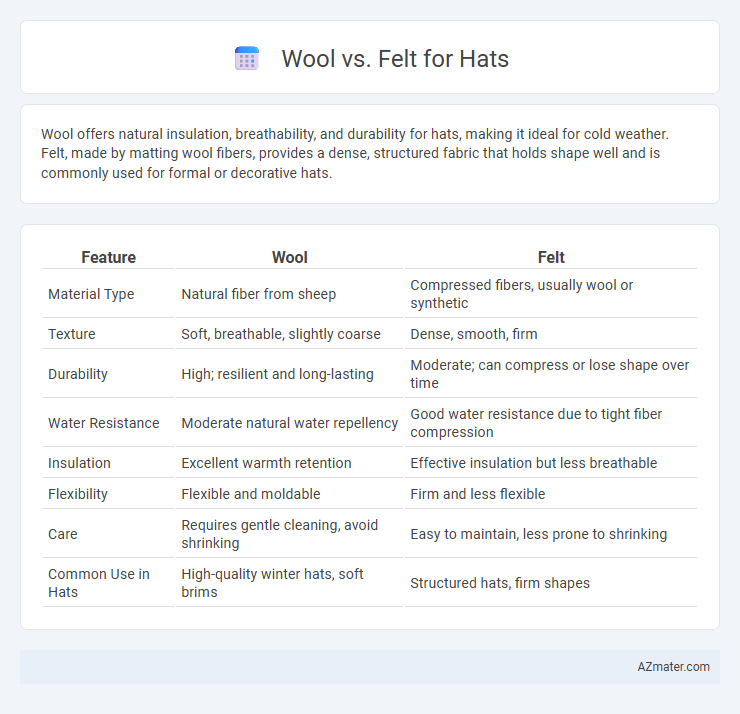Wool offers natural insulation, breathability, and durability for hats, making it ideal for cold weather. Felt, made by matting wool fibers, provides a dense, structured fabric that holds shape well and is commonly used for formal or decorative hats.
Table of Comparison
| Feature | Wool | Felt |
|---|---|---|
| Material Type | Natural fiber from sheep | Compressed fibers, usually wool or synthetic |
| Texture | Soft, breathable, slightly coarse | Dense, smooth, firm |
| Durability | High; resilient and long-lasting | Moderate; can compress or lose shape over time |
| Water Resistance | Moderate natural water repellency | Good water resistance due to tight fiber compression |
| Insulation | Excellent warmth retention | Effective insulation but less breathable |
| Flexibility | Flexible and moldable | Firm and less flexible |
| Care | Requires gentle cleaning, avoid shrinking | Easy to maintain, less prone to shrinking |
| Common Use in Hats | High-quality winter hats, soft brims | Structured hats, firm shapes |
Introduction to Wool and Felt Hats
Wool hats, crafted from natural animal fibers, offer warmth, breathability, and durability, making them ideal for cold weather and outdoor use. Felt hats, created by matting and pressing wool or synthetic fibers, provide a smooth, dense texture that is easily shaped and resistant to moisture. Both materials are popular in hat-making for their unique qualities, with wool delivering natural insulation and felt excelling in structured designs.
Material Origins: Wool vs Felt
Wool originates from the fleece of sheep, harvested through shearing and processed into fibers that retain natural moisture and warmth. Felt, on the other hand, is a non-woven textile made by matting and compressing wool fibers or synthetic materials, creating a dense and sturdy fabric. The key difference lies in wool's preserved fiber structure versus felt's condensed, interlocked fibers, impacting durability, insulation, and texture in hat manufacturing.
Production Process Comparison
Wool hats are crafted by cleaning, carding, and spinning raw wool fibers into yarn, which is then woven or knitted before shaping into hats. Felt hats undergo a different process where wool fibers are matted, compressed, and pressed together using heat, moisture, and pressure, creating a dense, non-woven fabric ideal for hat making. The felting process results in a more structured and water-resistant hat, while the woven wool method offers greater flexibility and breathability.
Durability and Longevity
Wool hats offer exceptional durability due to their natural fiber strength and resistance to wear, ensuring long-lasting performance even with frequent use. Felt hats, made from compressed fibers, provide excellent shape retention and resilience but may show signs of wear faster under rough conditions compared to wool. Choosing between wool and felt for hat durability depends on the intended use, with wool excelling in rugged environments and felt favored for maintaining structure in more controlled settings.
Comfort and Fit Differences
Wool hats provide superior breathability and moisture-wicking properties, making them comfortable for extended wear in various climates. Felt hats, often made from compressed wool fibers, offer a denser texture that molds closely to the head, resulting in a snugger and more structured fit. The softness of wool contrasts with the firmer feel of felt, influencing both the hat's flexibility and how it conforms to different head shapes.
Style and Appearance
Wool hats offer a smooth, polished finish with a natural sheen that enhances classic and modern styles, making them ideal for structured designs like fedoras and cloches. Felt hats, crafted from compressed fibers, provide a matte texture and a more textured, rustic look, lending themselves well to vintage or artisan styles. The choice between wool and felt impacts not only the hat's durability but also its visual appeal, with wool delivering sleek sophistication and felt offering a cozy, handcrafted charm.
Weather Resistance and Practicality
Wool hats offer superior water resistance and breathability, making them ideal for wet and variable weather conditions, while felt hats provide excellent wind resistance and durability in cold, dry environments. Wool fibers naturally repel moisture and retain heat without overheating, enhancing comfort during outdoor activities. Felt hats maintain their shape well, are easy to clean, and offer practical protection against wind chill, making them a practical choice for harsh winter weather.
Care and Maintenance Requirements
Wool hats require gentle hand washing with cold water and mild detergent to maintain their shape and texture, while avoiding excessive heat to prevent shrinking. Felt hats benefit from regular brushing with a soft-bristle brush to remove dust and debris, and spot cleaning with a damp cloth for stains without soaking the material. Both materials should be stored in a cool, dry place away from direct sunlight to preserve their color and durability.
Price and Accessibility
Wool hats typically offer higher durability and natural breathability but come with a steeper price due to the quality of raw materials, often ranging from $50 to $200 or more. Felt hats, made from compressed fibers like wool, synthetic blends, or fur, tend to be more affordable and accessible, with prices commonly between $20 and $100, making them a popular choice for budget-conscious buyers. Availability in retail and online stores is higher for felt hats due to easier production methods and a wider variety of synthetic options.
Choosing the Best Material for Your Hat
Wool offers durability, breathability, and moisture-wicking properties, making it ideal for versatile, everyday hats that provide warmth and comfort. Felt, created by matting fibers tightly together, delivers a denser, more structured finish suitable for stylish, formal hats and shapes that hold well over time. When choosing the best material for your hat, consider wool for its natural insulation and flexibility versus felt's rigid texture and refined appearance to match your style and functional needs.

Infographic: Wool vs Felt for Hat
 azmater.com
azmater.com